Resistant Dextrin vs Cluster Dextrin: Why the Smarter Choice for Gut Health Is Clear
August 22, 2025

In the world of functional carbohydrates and fiber-enhancing ingredients, Resistant Dextrin has quietly become a go-to solution for food, beverage, and nutraceutical brands looking to deliver genuine health benefits. While other dextrins—such as Cluster Dextrin (Highly Branched Cyclic Dextrin)—are gaining attention in performance and stability applications, they serve very different purposes.
If your focus is on digestive wellness, metabolic health, and consumer-friendly nutrition, the evidence points strongly in favor of Resistant Dextrin. Let’s break down what it is, how it works, and how it stacks up against Cluster Dextrin.
What Is Resistant Dextrin?
Resistant dextrin is a soluble dietary fiber made by carefully processing starches—most commonly corn or tapioca—through enzymatic hydrolysis and controlled heat treatment. The “resistant” part refers to its ability to pass through the small intestine without being digested.
Once it reaches the large intestine, resistant dextrin acts as a prebiotic, feeding beneficial gut bacteria. These microbes ferment it into short-chain fatty acids (SCFAs) such as butyrate, propionate, and acetate, which have multiple health benefits ranging from improved digestion to better metabolic regulation.
This functional fiber is:
- Neutral in taste – making it easy to incorporate into foods and beverages without altering flavor.
- Highly soluble – dissolving easily into liquids and batters.
Stable under heat and acidic conditions – suitable for a wide range of manufacturing processes.
The Proven Health Benefits of Resistant Dextrin
Resistant dextrin’s health value comes from its dual role as a functional ingredient and a nutritional powerhouse. Here’s what makes it stand out:
1. Supports Digestive Regularity
As a soluble fiber, resistant dextrin absorbs water and adds bulk to stool, promoting healthy bowel movements. This makes it beneficial for those dealing with occasional constipation or irregularity.
2. Feeds Beneficial Gut Bacteria
Because it resists digestion, resistant dextrin becomes a slow-release food source for gut microbes. This helps boost populations of beneficial bacteria, which can improve digestion, immune function, and even mood regulation.
3. Helps Control Blood Sugar Spikes
Resistant dextrin slows the absorption of carbohydrates from meals, leading to a more gradual rise in blood glucose levels. This can help with glycemic control, making it a smart choice for people with insulin resistance or those managing type 2 diabetes.
4. Aids Weight Management
By increasing feelings of fullness, resistant dextrin can help reduce overall calorie intake without requiring restrictive diets. This satiety effect is especially useful in formulating meal replacement shakes and weight-control snacks.
5. Supports Heart Health
Some studies have shown resistant dextrin may help lower total cholesterol and LDL (“bad”) cholesterol, contributing to cardiovascular wellness.
6. Gentle on the Digestive System
Unlike some fibers that can cause bloating or gas in sensitive individuals, resistant dextrin is generally well-tolerated and suitable for long-term use.
Where Resistant Dextrin Works Best
The versatility of resistant dextrin is one of its biggest advantages. Because it’s neutral in taste and texture, it can be used in:
- Beverages – from flavored waters to functional smoothies.
- Baked Goods – breads, muffins, high-fiber cookies.
- Dairy & Plant-Based Products – yogurts, ice creams, dairy alternatives.
- Nutraceuticals – powdered drink mixes, meal replacements, fiber supplements.
- Sauces & Dressings – where stability and a smooth mouthfeel are key.
This means product developers can add functional fiber without compromising flavor or texture—a major plus for consumer acceptance.
A Quick Look at Cluster Dextrin (Highly Branched Cyclic Dextrin)
Cluster Dextrin, often marketed as Highly Branched Cyclic Dextrin (HBCD), is produced from waxy corn starch through an enzymatic process that creates a unique branched structure.
Its strengths are different from resistant dextrin:
- Excellent solubility and stability in both hot and cold liquids.
- Low osmotic pressure, meaning it’s easier on the stomach during intense exercise.
- Steady energy release, making it popular in sports nutrition formulas.
- Technical versatility for encapsulating flavors or active ingredients.
While Cluster Dextrin is valuable in specific contexts—particularly for athletes—it’s not a dietary fiber and does not provide the prebiotic or metabolic benefits that resistant dextrin does.

Why Resistant Dextrin Outperforms for Everyday Health
If your target market is general wellness, digestive health, and lifestyle nutrition, resistant dextrin is the more impactful choice. It directly addresses the growing consumer demand for:
- Gut health – one of the fastest-growing functional food trends.
- Blood sugar management – relevant for both healthy aging and weight control.
- Clean label fiber fortification – with minimal sensory changes.
In contrast, Cluster Dextrin’s benefits are more performance-oriented, serving a niche audience of athletes and fitness enthusiasts.
Key Differences at a Glance

How to Incorporate Resistant Dextrin Into Product Formulation
For brands and formulators, using resistant dextrin effectively means considering:
- Dosage – Typically 3–8g per serving to make meaningful fiber claims.
- Product Positioning – Pairing with other gut-health ingredients like probiotics for synergistic benefits.
- Marketing Language – Highlighting “supports digestive health” and “prebiotic fiber” claims to resonate with health-conscious consumers.
- Labeling – Ensure clear, compliant statements for target markets (e.g., “contains soluble fiber to support digestive health”).
The Consumer Appeal of Resistant Dextrin
Modern consumers are increasingly label-savvy. They want:
- Functional benefits backed by science.
- Clean, natural-sounding ingredients.
- Products that fit into their daily routine without sacrifice in taste or texture.
Resistant dextrin ticks all these boxes. It delivers measurable health value, is easy to work with in manufacturing, and integrates seamlessly into everyday foods and beverages.
Bottom Line
Cluster Dextrin may shine in sports performance formulas, but for broad-spectrum health and wellness, Resistant Dextrin takes the lead. It offers fiber fortification, prebiotic activity, metabolic support, and consumer-friendly formulation flexibility—all in a neutral, stable form.
For brands looking to meet the growing demand for gut health and wellness products, Resistant Dextrin from Satoria Nutrisentials is the clear choice.
Whether your goal is to create a better-for-you beverage, a high-fiber snack, or a daily supplement, resistant dextrin can elevate your formulation—and your customer’s health—without compromise.